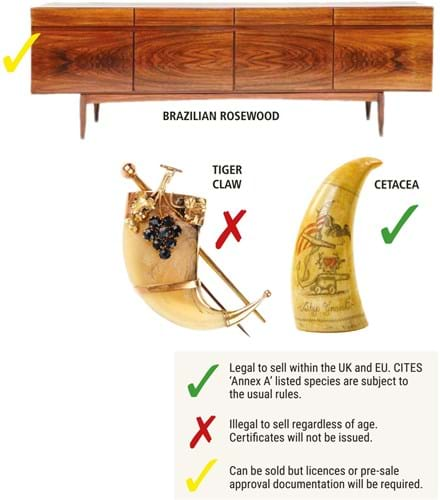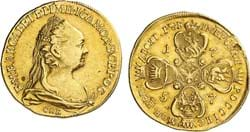During the run-up to Brexit, the UK Government issued a series of ‘transition’ announcements (see ATG No 2471), regarding the new rules for endangered species (CITES – Convention on International Trade in Endangered Species of Wild Fauna and Flora). The slogan was Check, Change and Go.
If that implied some major changes to CITES then that was not the intention: CITES has not changed.
It is still as it ever was – a system of permits to accompany any foreign shipment of items that are manufactured from or include an endangered species, irrespective of age. And in the majority of cases, the rules are much the same, except to say that as the UK is no longer part of the EU it must operate with a ‘harder’ border.
The changes
Prior to Brexit, shipment of items made from endangered species within the EU was simple. As there was free movement throughout the member states, sending an antique tortoiseshell tea caddy or a leopard skin rug from the UK to Berlin or Paris was no different to sending it to Bognor Regis.
It required little paperwork and no CITES re-export/export/import documentation as all the EU member states were classed as one country.
Post Brexit (from January 1, 2021), this has changed. When shipping to and from EU countries you will now need to use designated entry and exit points and supply new documentation including CITES permits (import; export and/or re-export permits).
In other words, you now treat the EU member states as you would shipping an item to Australia, the US or any other foreign county.
In fact, it can be more complicated as a transaction to the EU has the added complication of needing a CITES permit at both ends. Sending an item to Australia does not necessarily need an Australian import permit – just a UK export/ re-export permit. The EU demands both the export permit and an EU import permit and both require a fee. It is something to remember when dealing with EU clients – there are now extra costs involved.
Designated points of entry/exit
There are only certain points of exit/entry that will handle CITES paperwork when dealing with the EU. An updated list can be found by visiting the gov.uk website.
This is normally only relevant to shipping agents but gone are the days when an EU buyer can attend an auction and drive back home with their purchase of a CITES item. First, there is the delay of acquiring the correct CITES permits (these cannot be ordered in advance) and secondly, they need to check that the port or airport they use can handle CITES paperwork.
Northern Ireland
One of the quirks of Brexit is that when dealing with or shipping to and from Northern Ireland it must now be treated as you would an EU member state – that means CITES permits will be required. Historically when dealing with the Channel Islands and The Isle of Man, CITES paperwork has always been required – we now have to add Northern Ireland to the list.
UK CITES permits are available from APHA (Animal & Plant Health Agency), Horizon House, Deanery Road, Bristol BS1 5AH. Tel 0117 373 3700. Currently a re-export certificate costs £37.
EU buyers will need to contact their own CITES managing authority to arrange any import permits.
gov.uk/cites-imports-and-exports
Article 10 sales licences
Post-Brexit nothing has changed regarding Article 10 sales licences. For the time being, the UK has simply transposed EU law into UK law so in effect EU Council regulations 338/97 still exists as part of UK Law. Article 10 licences will therefore still be valid and required prior to the sale of any EC Annex A (now UK Annex A) specimen that are either ‘un-worked’ (any age) or ‘worked’ post 1947 in origin.
The cut-off date of March 3, 1947, is still in force and (since 2019) it has been necessary to publish the licence number of the item for sale in your catalogues (both hard copy and online). Currently an Article 10 certificate costs £31.
Other changes
Over recent years there have been a few changes to policy and additions to animals and plants on the most endangered listings. These tend to happen shortly after a conference of the CITES parties – the most recent being in 2018.
Whereas a few years ago we needed to obtain a pre-sale approval prior to trading in antique rhino horn, this has now been relaxed and discontinued allowing the sale of fully ‘worked’ items made from or including rhino horn providing its origin is pre-1947.
There is, however, one important caveat to this and that is you will not be able to export it from the UK unless the hammer price exceeds $100 per gram in weight. In practice this means that only fine antiques such as Ming and Qing libation cups will be allowed out of the country (and even that is subject to agreement by a panel).
This means that while it is legal to sell worked rhino horn walking canes or knobkerries without any need to obtain written confirmation, the hammer price will also probably dictate that you cannot ship it out of the UK.
Elephant ivory
The Ivory Act 2018 has been covered at length in ATG – so we will be aware of the forthcoming changes to the trade in ivory.
At the time of this update, the trade in antique ivory has not been affected but this will change in the coming months when the act comes into force.
There will be exemptions for pre-1918 portrait miniatures, sales or loans to museums, objects of ‘outstandingly high artistic, cultural or historical value’ and a de minimus rule that will allow for the sale of pre-1947 objects with less than 10% ivory (eg furniture inlays or the insulators to a silver teapot) and musical instruments with less than 20% ivory.
Before this, however, a consultation is required on technicalities and fees, so we await to see how this will work in practice.
A consultation is now also under way in the EU regarding new controls on the sale of elephant ivory.
While the provisions of the Ivory Act 2018 are generally more stringent, the EU is proposing to no longer permit commercial imports and exports of any elephant ivory object regardless of age (see News, ATG No 2480).
Sawfish rostrums
It is surprising that quite a few dealers and auctioneers remain unaware that sawfish rostrums (Pristidae) are listed in CITES Appendix I/Annex A and therefore require an Article 10 licence if ‘unworked’, which most are.
Tortoiseshell
There has been one change of policy toward turtle/ tortoiseshell in recent years.
Polished shells ready for wall hanging used to be classed as ‘worked’ and were therefore exempt from licensing under the antiques derogation.
These are now classed as ‘unworked’ and require Article 10 certification. It is only when turtle/tortoiseshell is worked or when it is part of a larger taxidermy mount (with head and legs) that it becomes covered by the antiques derogation.
Tiger and other ‘big cat’ skins
When selling animal skins of CITES species the ruling was that a ‘worked’ specimen had to have a backing material or the head had to be mounted. This has now been relaxed and pre-1947 skins can be sold under the antiques derogation providing they have been tanned.
Rosewood
There are many species of rosewood but only one that features on the most endangered (CITES Appendix 1/UK Annex A) lists.
This is Brazilian rosewood (Dalbergia nigra) and any post-1947 item made from or including this species requires an Article 10 licence prior to being sold and of course the licence number must be published with the description, whether in a shop or an auction catalogue.
Brazilian rosewood was used in both Scandinavian post-war furniture and in musical instrument manufacture, particularly on the fretboards of guitars into the 1970s.
The issue here is with positive identification, as Dalbergia nigra can look much like other species of rosewood (that are listed as Annex B meaning that no Article 10 is necessary). Chemical testing at a laboratory in Kew is possible but is both expensive and the results not guaranteed if the timber has been treated with varnish, stain, wax or bleach.
For some time the safe option when selling 1950s-60s rosewood was to apply for an article 10 certificate ‘just in case’. However, this significantly skews the true figure of how much endangered Dalbergia nigra is being traded – the essence of the CITES concept.
The most recent guidance from APHA is “customers should only apply for permits and certificates for Dalbergia nigra when they have reason to believe that the specimen is made from that species”. But where does that leave us?
Designer handbags
There are similar problems with crocodile, alligator and snake bags. The famous brands do not always label the species used.
We can presume it is one of the farmed species such as American alligator (Alligator mississippiensis) or salt water crocodile (Crocodylus porosus) or Nile crocodile (Crocodylus niloticus) but if challenged by the authorities this can be difficult to prove – and can you prove it was legally imported into the EU? Where an authority wants the precise species (US Fish & Wildlife typically ask), it presents a problem.
Horns and antlers
Pre-1947 horns or antlers of CITES species listed Annex A used to be classed as ‘worked’ when they were mounted on a wooden shield. This is no longer the case. Any such item whether un-mounted or on a shield, whatever the age, will require a licence (Article 10). The same ruling goes for skulls or any ‘raw’ bone.
Recent additions
At the most recent Conference of the Parties, one or two notable additions were placed on the CITES listings. Species of pangolin (Manis spp) are now listed in Annex A so any post-war mount or unworked scales and skins now require an Article 10 licence.
Giraffe (Giraffa camelopardalis) is now listed in Annex B, so although not requiring Article 10 sales licences, they will require CITES permits for international movement.
The golden rule when dealing in CITES species is to ask questions. If unsure check it out with the UK CITES Authority (APHA – Animal & Plant Health Agency).
You can contact Kim McDonald at kim@taxidermylaw.co.uk
More on this topic in ATG's in-depth CITES guide















